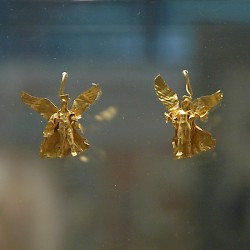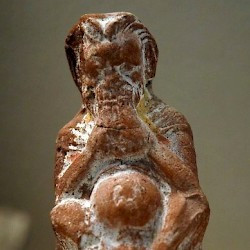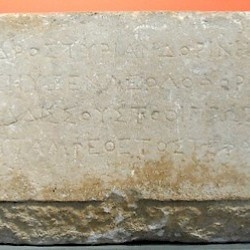Jona Lendering
Jona Lendering read history at Leiden University (MA 1993), specialized in Mediterranean culture at the Amsterdam Free University (MA 1996), and worked at excavations in Holland (Riethoven) and Greece (Halos). After teaching historical theory and ancient history at the Free University for several years, he was one of the founders of a school for history teaching, Livius Onderwijs. Born in Amsterdam, it has now spread to auxiliary locations in Bussum, Dronten, Gouda, Haarlem, Hoorn, Schagen, Zaanstad, and Zoetermeer. As of 2013, Livius Onderwijs has eight teachers, about 500-600 students a year, and offers tours to countries like Italy, Turkey, Iran, and Lebanon. The field trips help to etch into the students' minds some of what they've learned at the school.
Because history is for a large part telling a story, something you do best in your own language, Lendering prefers to publish in Dutch journals. However, he has contributed to the Bryn Mawr Classical Review and Ancient Warfare, while he is the founder of Ancient History Magazine. He is also the publisher and editor of the on-line publication of the Babylonian Chronicles of the Hellenistic Period, a set of important cuneiform sources for the history of the Seleucid and Parthian Near East, transcribed, translated and commented on by Bert van der Spek of the Free University Amsterdam and Irving Finkel of the British Museum. A publication as book is in preparation.
Lendering has written several books and maintains a blog in Dutch. He is the author of several books, including Edge of Empire and Consensus and Crises. For the Livius website, which has received several awards, he collaborates closely with Bill Thayer of LacusCurtius. Lendering is also the webmaster of two daily blogs, the MainzerBeobachter.com and Grondslagen.net.
There are 9380 items in Jona Lendering:
Amman, Jordan Museum
A splendid, modern museum, documenting Jordan's past from prehistory until Late Antiquity. A part of the collection originates from the old Archaeological Museum on the citadel of Amman. One of the most beautiful museums in the Middle East. …Ammianus Marcellinus
Ammianus Marcellinus: Roman historian, writing in the fourth century.Amminapes
Amminapes: Parthian nobleman, who played a role in the struggle between the Achaemenid Empire and Alexander the Great. A Parthian. Relief…Ammon (deity)
Ammon: name of a Libyan deity and his oracle in an oasis in Egypt's western desert. It became famous after Alexander the Great made a detour to consult the god. The modern name of the oasis is Siwa. …Ammon (kingdom)
Ammon: Bronze and Iron Age kingdom, east of the river Jordan. The Jabbok According to the Biblical book of Judges,note[Judges 11.13] the…Ammon (Siwa)
Ammon: name of a Libyan deity and his oracle in the desert. It became famous after Alexander the Great made a detour to consult the god. The modern name is Siwa. …Amorges
Amorges: son of Pissuthnes, satrap of Lydia, continued his father's revolt against the Achaemenid king Darius II Nothus.Pissuthnes had been the satrap of Lydia for at least two decades when he decided to revolt against king Darius II Nothus in…Amphipolis (Ennea Hodoi)
Amphipolis: Greek town in Thrace, colony of Athens, of great strategic importance. Its port was Eïon. Map of Amphipolis and Eïon Human…Amphipolis, Archaeological Museum
Well-kept, modern museum with finds from Amphipolis. There are 20 items in Amphipolis, Archaeological Museum: …

Amphipolis, Earrings |

Amphipolis, Figurine of Pan |

Amphipolis, Inscription of Antigonus Kallas, victor in Alexander the Great's games in Tyre |